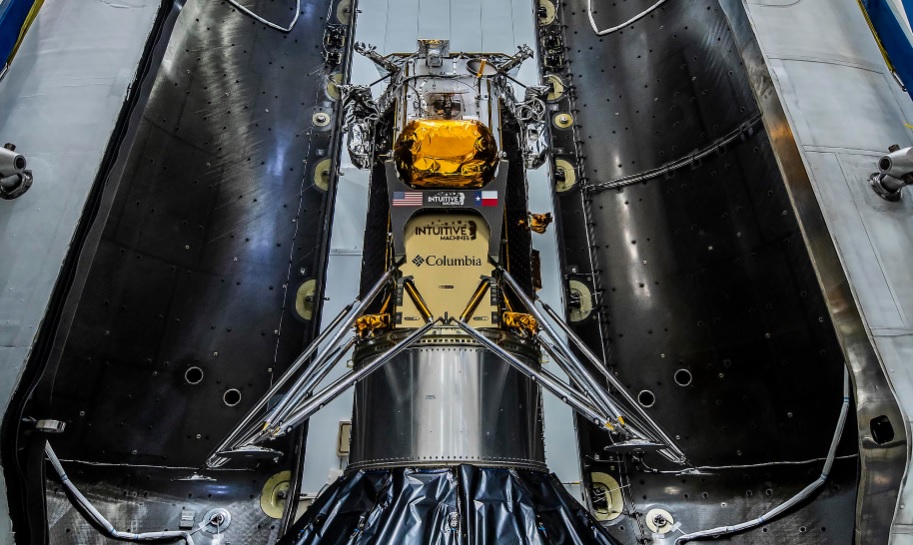The second Commercial Lunar Payload Services mission of 2024 IM-1 Nova-C heads Moonward.

NASA
The Moon is becoming a busy place. A SpaceX Falcon 9 rocket lit up the skies over the Kennedy Space Center on the Florida Space Coast early this morning, putting Intuitive Machines’ Nova-C lander on a course for the Moon. Liftoff of mission IM-1 occurred at 1:05 a.m. EST / 6:05 UT on February 15th, and spacecraft separation occurred 48 minutes after launch. Controllers report that IM-1 is in good health post-launch. The launch was bumped back 24 hours from February 14th after a technical issue.
This launch marks the second mission bound for the Moon aboard a SpaceX rocket (the first was the Korean Pathfinder Lunar Orbiter in 2022), and the first SpaceX launched mission to attempt to land on the Moon. IM-1 is also the first lunar mission launched from the historic LC-39A launch pad at the Kennedy Space Center since the final mission of the Apollo program, Apollo 17, in 1972. If successful late next week, the Nova-C will also be the first U.S. soft landing on the Moon since the Apollo program.

Hap Griffin
Nova-C Heads Moonward
Nova-C is part of NASA’s Commercial Lunar Payload Services (CLPS) initiative, which encourages private companies to launch payloads to the Moon. Last month, the first CLPS mission, Astrobotic’s Peregrine lander, attempted to leave Earth's gravity with the inaugural launch of United Launch Alliance’s Vulcan-Centaur rocket. That lander, plagued with difficulties, didn't make it to the Moon and returned instead to Earth for reentry on January 18th.

Intuitive Machines
Now, the Nova-C lander, officially named Odysseus, will head for Malapert A Crater near the lunar south pole, entering lunar orbit next week around February 21st and touching down around February 22nd. The lander will operate for 14 days (one lunar day) before succumbing to the cold of lunar night.

NASA/CLPS
A descendant of NASA’s Morpheus Project, Odysseus stands 3 meters (10 feet) tall and weighs in at 1,931 kilograms (4,257 pounds) at launch. Aboard are six NASA experiments, which serve a number of science goals. According to NASA, the payloads will collect data on how the plume of engine gasses interacts with the Moon’s surface and kicks up lunar dust, investigate radio astronomy and space weather interactions with the lunar surface, an instrument to test precision landing technologies, and a test to measure the quantity of liquid propellant in Nova-C propellant tanks in the zero gravity of space. NASA is also fielding a laser retroreflector array on Nova-C to measure its precise position after landing.
Columbia Sportswear is also testing its Omni-Heat Infinity material on the lander, as a heat reflective covering on the spacecraft's closeout panel and the cryogenic propulsion tank.
The lander will also carry the Galactic Legacy Labs’ Lunaprise memorial and Moon Phases sculptures by artist Jeff Koons. Another project by Embry-Riddle Aeronautical University named EagleCAM is a CubeSat camera system that will deploy before landing, with the goal of grabbing a 'selfie' of Nova-C as it descends toward the lunar surface.
Another project, fielded by the International Lunar Observatory Association and known as ILO-X sits atop the Nova-C lander. ILO-X is a precursor to a flagship lunar south pole observatory, which ILOA plans to put on top of the 5,000-meter Malapert Massif in 2026. To validate the technologies required, ILO-X will use two 30mm-aperture instruments to carry out astronomical observations of Earth, the Milky Way, and other celestial targets.

Intuitive Machines
Built by Canadensys Aerospace, ILO-X has several main goals during its short two weeks of operation. “One is galaxy imaging, in particular, to capture the first image of the Milky Way Galaxy from the Moon (since Apollo 16),” says Steve Durst (International Lunar Observatory Association). “There may be an iconic value, similar to the first image of the Earth from the Moon [Earthrise] last century.”
ILO-X follows a legacy of astronomical observations from the surface of the Moon. The first true telescope based on the lunar surface was the Far Ultraviolet Camera and Spectrograph instrument, left on the Moon by Apollo 16 astronauts in 1972. More recently, China fielded the Lunar-based Ultraviolet Telescope (LUT) on the Chang’e 3 mission in 2014. ILOA had a memorandum of understanding to work with China on Chang’e 3 in 2014, and will reciprocate with ILO-X.

NASA
The IM-1 mission will be the third lunar landing attempt in 2024. Besides Peregrine 1, the other was Japan’s SLIM mission, which made a lopsided landing at Shioli Crater. It managed to briefly charge its batteries and take some data before falling silent at lunar sunset at the end of January.
What’s Next for Moon Missions in 2024
Next up in 2024, at least in terms of lunar missions, is Intuitive Machines’ plans to bring the PRIME-1 drill to the lunar south pole in March, in search of subsurface lunar water ice. China’s Chang’e 6 mission is also headed moonward in May, for the first-ever farside sample return. Later this year, Astrobotic will make another attempt for the Moon with its Griffin Mission One, which will carry NASA’s VIPER rover.
Good luck and safe journeys to Odysseus, ahead of the February 22nd landing.
 0
0









Comments
You must be logged in to post a comment.